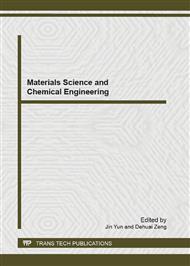p.3
p.7
p.11
p.17
p.22
p.28
p.34
p.40
Advances Research on Preparation of Magnesium Carbonate Whisker
Abstract:
Magnesium carbonate whisker is a single crystal of magnesium carbonate crystal, which has an integral crystal growth, and small defects, furthermore, it is colorless, transparent, and has high-intensity. It has an incomparable property compared to other conventional whiskers. It is a cost-effective whisker; thus has been of great interest due of this characteristic. Reported magnesium carbonate whiskers have been increased gradually since the beginning of this century. The preparation of magnesium carbonate whisker can be done by using chemicals as raw material, as well as by using natural resources, such as: seawater concentrated liquid and magnesite. Although magnesite resources are abundant in China, its low exploitation and utilization had long been the reason for low grade ore problems. The use of magnesium ore to optimize conditions for the preparation of magnesium carbonate whisker by adjusting reaction conditions, not only took advantage of mineral resources, but also helped to achieve industrial production of magnesium carbonate whiskers. We also analyzed how some factors had influenced the morphologies of MgCO3•3H2O, such as: reaction temperature, reaction time, and stirring speed etc.
Info:
Periodical:
Pages:
17-21
Citation:
Online since:
May 2013
Authors:
Keywords:
Price:
Сopyright:
© 2013 Trans Tech Publications Ltd. All Rights Reserved
Share:
Citation:


